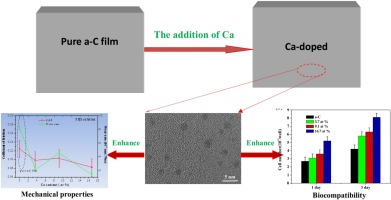当前位置:
X-MOL 学术
›
Colloids Surf. B Biointerfaces
›
论文详情
Our official English website, www.x-mol.net, welcomes your feedback! (Note: you will need to create a separate account there.)
In vitro and in vivo biocompatibility and bio-tribological properties of the calcium/amorphous-C composite films for bone tissue engineering application.
Colloids and Surfaces B: Biointerfaces ( IF 5.8 ) Pub Date : 2020-01-11 , DOI: 10.1016/j.colsurfb.2020.110792 Dongguang Liu 1 , Haoran Ma 2 , Yan Liang 3 , Liang Zheng 4
Colloids and Surfaces B: Biointerfaces ( IF 5.8 ) Pub Date : 2020-01-11 , DOI: 10.1016/j.colsurfb.2020.110792 Dongguang Liu 1 , Haoran Ma 2 , Yan Liang 3 , Liang Zheng 4
Affiliation

|
Carbon-and diamond-like-carbon coated Ti alloys hold great promise for tissue engineering applications. Unfortunately, their strong intrinsic stress leads to the adhesion failure of the films. Herein, a series of a-C films with different Ca content were prepared on Ti6Al4V via co-sputtering deposition technology. Homogeneous spherical Ca nanoclusters, with an inner diameter of 2-6 nm, were formed in an amorphous carbon matrix. The addition of Ca induced indistinctive variation in either phase composition or topography. However, the introduction of Ca not only improved the mechanical properties of a-C film but also significantly strengthened its adhesion to osteoblasts. The bio-tribological properties of Ca/a-C films were also assessed using a tribometer in FBS solution. The Ca/a-C films exhibited a low friction coefficient of 0.083 and a low wear rate of 1.02-1.24×10-6 mm3/Nm. The low coefficient of friction (COF) of the Ca/a-C films indicates their superior mechanical properties, making them the promising target of nanocomposite films used in bio-tribological applications. Well-stretched cells and the developed actin filaments were distinctly observed on the Ca/a-C films in the osteoblast cell adhesion experiments. In addition, the Ca/a-C films promoted cell proliferation and showed high cell viability. After being implanted for 4 weeks, the Ca/a-C implant material still adhered well to the muscle tissue, without inducing hyperergic or inflammatory reactions. Collectively, our results suggest that the Ca/a-C film is an ideal mounting material for bone tissue engineering.
中文翻译:

钙/无定形C复合膜在骨组织工程应用中的体外和体内生物相容性和生物摩擦学特性。
碳和类金刚石碳涂覆的钛合金在组织工程应用中具有广阔的前景。不幸的是,它们强大的固有应力导致薄膜的粘合失败。本文通过共溅射沉积技术在Ti6Al4V上制备了一系列不同Ca含量的aC膜。在无定形碳基质中形成内径为2-6 nm的均质球形Ca纳米簇。Ca的添加引起相组成或形貌的明显变化。然而,Ca的引入不仅改善了aC膜的机械性能,而且显着增强了其对成骨细胞的粘附性。还使用摩擦计在FBS溶液中评估了Ca / aC膜的生物摩擦学特性。Ca / aC膜的摩擦系数低至0。083,低磨损率1.02-1.24×10-6 mm3 / Nm。Ca / aC膜的低摩擦系数(COF)表示其优越的机械性能,使其成为在生物摩擦学应用中使用的纳米复合膜的有希望的目标。在成骨细胞粘附实验中,在Ca / aC膜上清楚地观察到拉伸良好的细胞和发达的肌动蛋白丝。另外,Ca / aC膜促进细胞增殖并显示高细胞活力。植入4周后,Ca / aC植入材料仍然很好地粘附在肌肉组织上,而不会引起高能或炎症反应。总的来说,我们的结果表明Ca / aC膜是用于骨组织工程的理想安装材料。Ca / aC膜的低摩擦系数(COF)表示其优越的机械性能,使其成为在生物摩擦学应用中使用的纳米复合膜的有希望的目标。在成骨细胞粘附实验中,在Ca / aC膜上清楚地观察到拉伸良好的细胞和发达的肌动蛋白丝。另外,Ca / aC膜促进细胞增殖并显示高细胞活力。植入4周后,Ca / aC植入材料仍然很好地粘附在肌肉组织上,而不会引起高能或炎症反应。总的来说,我们的结果表明Ca / aC膜是用于骨组织工程的理想安装材料。Ca / aC膜的低摩擦系数(COF)表示其优越的机械性能,使其成为在生物摩擦学应用中使用的纳米复合膜的有希望的目标。在成骨细胞粘附实验中,在Ca / aC膜上清楚地观察到拉伸良好的细胞和发达的肌动蛋白丝。另外,Ca / aC膜促进细胞增殖并显示高细胞活力。植入4周后,Ca / aC植入材料仍然很好地粘附在肌肉组织上,而不会引起高能或炎症反应。总的来说,我们的结果表明Ca / aC膜是用于骨组织工程的理想安装材料。在成骨细胞粘附实验中,在Ca / aC膜上清楚地观察到拉伸良好的细胞和发达的肌动蛋白丝。另外,Ca / aC膜促进细胞增殖并显示高细胞活力。植入4周后,Ca / aC植入材料仍然很好地粘附在肌肉组织上,而不会引起高能或炎症反应。总的来说,我们的结果表明Ca / aC膜是用于骨组织工程的理想安装材料。在成骨细胞粘附实验中,在Ca / aC膜上清楚地观察到拉伸良好的细胞和发达的肌动蛋白丝。另外,Ca / aC膜促进细胞增殖并显示高细胞活力。植入4周后,Ca / aC植入材料仍然很好地粘附在肌肉组织上,而不会引起高能或炎症反应。总的来说,我们的结果表明Ca / aC膜是用于骨组织工程的理想安装材料。不会引起过敏反应或发炎反应。总的来说,我们的结果表明Ca / aC膜是用于骨组织工程的理想安装材料。不会引起过敏反应或发炎反应。总的来说,我们的结果表明Ca / aC膜是用于骨组织工程的理想安装材料。
更新日期:2020-01-14
中文翻译:

钙/无定形C复合膜在骨组织工程应用中的体外和体内生物相容性和生物摩擦学特性。
碳和类金刚石碳涂覆的钛合金在组织工程应用中具有广阔的前景。不幸的是,它们强大的固有应力导致薄膜的粘合失败。本文通过共溅射沉积技术在Ti6Al4V上制备了一系列不同Ca含量的aC膜。在无定形碳基质中形成内径为2-6 nm的均质球形Ca纳米簇。Ca的添加引起相组成或形貌的明显变化。然而,Ca的引入不仅改善了aC膜的机械性能,而且显着增强了其对成骨细胞的粘附性。还使用摩擦计在FBS溶液中评估了Ca / aC膜的生物摩擦学特性。Ca / aC膜的摩擦系数低至0。083,低磨损率1.02-1.24×10-6 mm3 / Nm。Ca / aC膜的低摩擦系数(COF)表示其优越的机械性能,使其成为在生物摩擦学应用中使用的纳米复合膜的有希望的目标。在成骨细胞粘附实验中,在Ca / aC膜上清楚地观察到拉伸良好的细胞和发达的肌动蛋白丝。另外,Ca / aC膜促进细胞增殖并显示高细胞活力。植入4周后,Ca / aC植入材料仍然很好地粘附在肌肉组织上,而不会引起高能或炎症反应。总的来说,我们的结果表明Ca / aC膜是用于骨组织工程的理想安装材料。Ca / aC膜的低摩擦系数(COF)表示其优越的机械性能,使其成为在生物摩擦学应用中使用的纳米复合膜的有希望的目标。在成骨细胞粘附实验中,在Ca / aC膜上清楚地观察到拉伸良好的细胞和发达的肌动蛋白丝。另外,Ca / aC膜促进细胞增殖并显示高细胞活力。植入4周后,Ca / aC植入材料仍然很好地粘附在肌肉组织上,而不会引起高能或炎症反应。总的来说,我们的结果表明Ca / aC膜是用于骨组织工程的理想安装材料。Ca / aC膜的低摩擦系数(COF)表示其优越的机械性能,使其成为在生物摩擦学应用中使用的纳米复合膜的有希望的目标。在成骨细胞粘附实验中,在Ca / aC膜上清楚地观察到拉伸良好的细胞和发达的肌动蛋白丝。另外,Ca / aC膜促进细胞增殖并显示高细胞活力。植入4周后,Ca / aC植入材料仍然很好地粘附在肌肉组织上,而不会引起高能或炎症反应。总的来说,我们的结果表明Ca / aC膜是用于骨组织工程的理想安装材料。在成骨细胞粘附实验中,在Ca / aC膜上清楚地观察到拉伸良好的细胞和发达的肌动蛋白丝。另外,Ca / aC膜促进细胞增殖并显示高细胞活力。植入4周后,Ca / aC植入材料仍然很好地粘附在肌肉组织上,而不会引起高能或炎症反应。总的来说,我们的结果表明Ca / aC膜是用于骨组织工程的理想安装材料。在成骨细胞粘附实验中,在Ca / aC膜上清楚地观察到拉伸良好的细胞和发达的肌动蛋白丝。另外,Ca / aC膜促进细胞增殖并显示高细胞活力。植入4周后,Ca / aC植入材料仍然很好地粘附在肌肉组织上,而不会引起高能或炎症反应。总的来说,我们的结果表明Ca / aC膜是用于骨组织工程的理想安装材料。不会引起过敏反应或发炎反应。总的来说,我们的结果表明Ca / aC膜是用于骨组织工程的理想安装材料。不会引起过敏反应或发炎反应。总的来说,我们的结果表明Ca / aC膜是用于骨组织工程的理想安装材料。



























 京公网安备 11010802027423号
京公网安备 11010802027423号